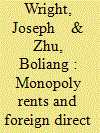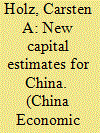|
|
|
Sort Order |
|
|
|
Items / Page
|
|
|
|
|
|
|
| Srl | Item |
| 1 |
ID:
160573


|
|
|
|
|
| Summary/Abstract |
In the past two decades, much of foreign direct investment (FDI) in the primary sector has flowed to unconventional, politically risky destinations. This presents a puzzle for theories that emphasize the ex post immobility of—and hence high potential expropriation risk for—fixed asset investment. Existing theories overlook one critical aspect of fixed assets: large capital requirements and high sunk costs act as entry barriers, resulting in market concentration and strong firm incentive for monopoly rent extraction. Personalist dictatorships, we posit, provide an attractive institutional environment for fixed asset investors. In such systems, the control of key economic sectors by the families of leaders, combined with a lack of institutional constraints, facilitate rent-seeking activities. We find that personalist dictatorships receive significantly more foreign investment in the primary sector, and fixed-asset intensive industries in general, than other regimes. This study highlights the importance of accounting for heterogeneity among investors and political regimes to understand the politics of FDI.
|
|
|
|
|
|
|
|
|
|
|
|
|
|
|
|
| 2 |
ID:
071987


|
|
|
|
|
| Publication |
2006.
|
| Summary/Abstract |
Data on physical capital are an indispensable part of economic growth and efficiency studies. In the case of China, economy-wide fixed asset series are usually derived by aggregating gross fixed capital formation (net of depreciation) over time, and sectoral/ownership-specific series by correcting the limited official fixed asset data available. These procedures, to varying degrees, ignore that (i) gross fixed capital formation does not equal investment, (ii) investment does not equal the value of fixed assets newly created through investment, (iii) depreciation is an accounting measure that bears no necessary relation to changes in the production capacity of fixed assets, (iv) official fixed asset data, where available, incorporate significant revaluations in the 1990s, and (v) "net fixed assets" do not measure the contribution of fixed assets to production.
This paper derives economy-wide fixed asset values for 1953-2003, correcting for these shortcomings. It uses both the traditional, cumulative approach and a new, so far unexplored method of combining economy-wide depreciation values and an economy-wide depreciation rate to directly yield economy-wide fixed assets. The derived fixed asset time series are evaluated in a comparison with each other as well as with series in the literature, leading to the recommendation of a specific choice of fixed asset time series.
|
|
|
|
|
|
|
|
|
|
|
|
|
|
|
|
| 3 |
ID:
178816


|
|
|
|
|
| Summary/Abstract |
Space heating using straw briquette fuel in China rural is an important method to replace fossil fuels and reduce greenhouse gas emissions. However, the price of straw briquette fuel is high in traditional supply chain. Therefore, a novel closed-loop supply chain centered on energy service station is proposed. An appropriate way to acquire fixed assets can promote the rapid development of energy service station. In order to find a better solution, the methods of net present value and entropy weight are adopted. The results show that the priority order for small-scale energy service station is operating lease (OL), purchasing with loans (PL), purchasing with own fund (PF) and financial lease (FL), while that for large-scale energy service station is PL, OL, PF, FL. The results indicate that for small-scale energy service station, the optimal way to acquire fixed assets is affected by loan interest rate, rent interest rate and discount rate, while for large-scale energy service station, the optimal way to acquire fixed assets is mainly affected by loan interest rate, and the discount rate and rent interest rate have a negligible influence on the decision.
|
|
|
|
|
|
|
|
|
|
|
|
|
|
|
|
|
|
|
|
|